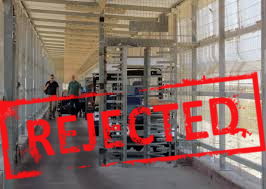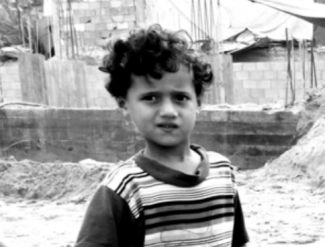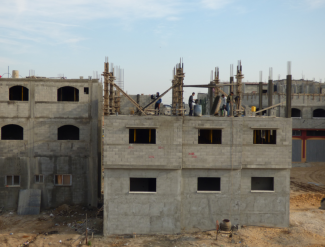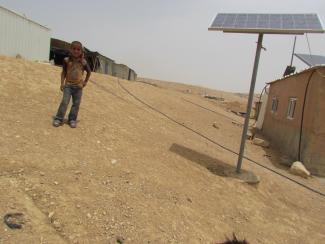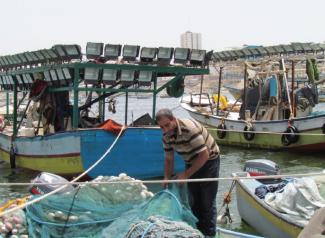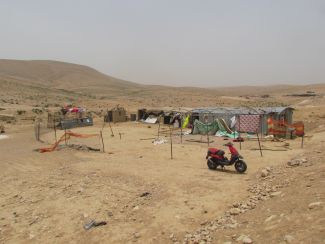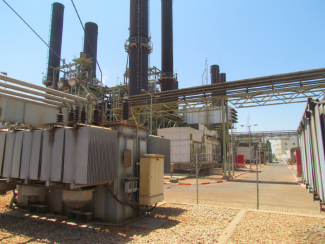Approval rates for permit applications for national staff working with international organizations (UN and INGO) to exit and enter the Gaza Strip have decreased significantly in 2016. Of the 128 local staff members (mostly UNRWA) who submitted an application in January, 119 permits were granted, an approval rate of 93 per cent. This declined to 83 per cent in February (53 approvals from 64 applications), to 57 per cent in March (35/62), before declining significantly to only 24 per cent in April (18/74). For the past five years, the annual approval rate has varied between 72 and 84 per cent.
The Monthly Humanitarian Bulletin | May 2016
Bedouin community in the Hebron area is at heightened risk of forcible transfer. Cement imports resume to the private sector in Gaza after a 45-day suspension. Permit approval rates for national staff working with international organizations to exit and enter the Gaza Strip have decreased significantly in 2016.
In this document
The Humanitarian Response Plan (HRP) for the occupied Palestinian territory (oPt) is part of the 2016 Global Humanitarian Overview, which is requesting a record US$20.1 billion to fund humanitarian operations around the world this year. The oPt HRP was launched locally in February and plans to support one in three Palestinians with some form of humanitarian assistance in 2016. It includes 206 projects worth $571 million, 19 per cent less than the sum requested in 2015. Seventy-nine organizations are participating: 12 UN agencies, 36 international NGOs and 31 national NGOs. Approximately one third of funds requested are designated as “top priority” to help guide where limited resources should be allocated first. Although the oPt HRP shares many of the features of other operations around the world, the context of the oPt is unique - a protracted protection crisis that stems from the impact of a military occupation approaching its 50th anniversary. Gender has been mainstreamed throughout all HRP objectives and all cluster strategies to ensure the protection of all members of the affected population and to guarantee effective and equitable delivery of humanitarian assistance.
45-day restrictions had impeded private housing repair and reconstruction
On 23 May, the Israeli authorities resumed the import of cement to the private sector in Gaza after a 45-day suspension. In a statement welcoming the resumption, the UN Special Coordinator for the Middle East Peace Process, Nickolay Mladenov, stated that “all sides need to ensure that cement deliveries reach their intended beneficiaries and are used solely for civilian purposes.”
The rate of demolitions across the West Bank slowed in May, following a sharp increase in the previous four months. However, the number of Palestinian structures destroyed since the beginning of 2016 has already exceeded the figures for all of 2015 (595 vs. 547). Referring to this year’s unprecedented figures, the UN Special Coordinator for the Middle East Peace Process, Nickolay Mladenov, in his briefing to the Security Council, observed that “although many of the structures that have been demolished are not dwellings, the loss of water wells, solar panels and animal shelters has impacted the livelihoods of over 2,500 people.” Throughout the West Bank, demolitions generate a coercive environment that exacerbates the risk of forcible transfer of already vulnerable Palestinian communities.
Since September 2000, Israel has tightened restrictions on Palestinian access to the sea and to land located near the fence with Israel – Access Restricted Areas – citing security concerns. These restrictions have been enforced through the firing of live ammunition, destruction of property, arrests, and the confiscation of equipment. While sea restrictions have varied, for the most part since 2006 fishermen have been allowed to access less than one third of the fishing areas allocated to them under the Oslo Accords: six out of 20 nautical miles (NM). Fish, particularly sardines, is a major source of protein, micronutrients and essential Omega 3 fatty acids for Palestinians in Gaza and contributes to nutritional diversity The fish available in the six NM area tend to be smaller in size, limiting the type of nets that can be used, reducing the value of the catch and undermining the sustainability of marine resources. Over 35,000 Palestinians depend on this industry for their livelihoods.
It is estimated that 990,000 people in Gaza and the West Bank, including East Jerusalem need emergency and early recovery shelter support and essential non-food items (NFIs) in 2016. The Shelter Cluster response plan addresses the needs of the most vulnerable, some 200,000 people, who have been displaced or are at risk of displacement as a result of manmade or natural disasters. Some $112 million has been requested through the HRP.
The forcible transfer of protected persons from their normal place of residence is prohibited under Article 49 of the Fourth Geneva Convention, which also forbids deportations outside an occupied territory. Many Palestinian families and communities throughout the occupied West Bank, including East Jerusalem, are at risk of forcible transfer because Israeli practices have created a coercive environment that puts pressure on them to move, mainly through the unavailability of building permits, which are almost impossible to acquire. Although Bedouin and herders in Area C bear the brunt of this pressure, forcible transfer also takes other forms. The article below is part of a series of articles in the Humanitarian Bulletin highlighting a range of situations across the oPt where Palestinians have been placed at heightened risk of forcible transfer.
On 8 April, the Gaza Power Plant (GPP) shut down completely after exhausting its fuel reserves due to a shortage of funds. This triggered electricity blackouts of 18-20 hours per day, up from 12 hours previously, further undermining the delivery of basic services, including the supply of water to households. The severe fuel shortages have caused the GPP to operate at approximately half of its capacity (60 out of 120 MW) or below since July 2013 and it has been forced to shut down on several occasions. ln addition to the GPP, Gaza depends on the purchase of electricity from Israel (120 MW) and Egypt (30 MW). The electricity supply was further reduced in the first part of May when the two power lines from Egypt stopped functioning.
